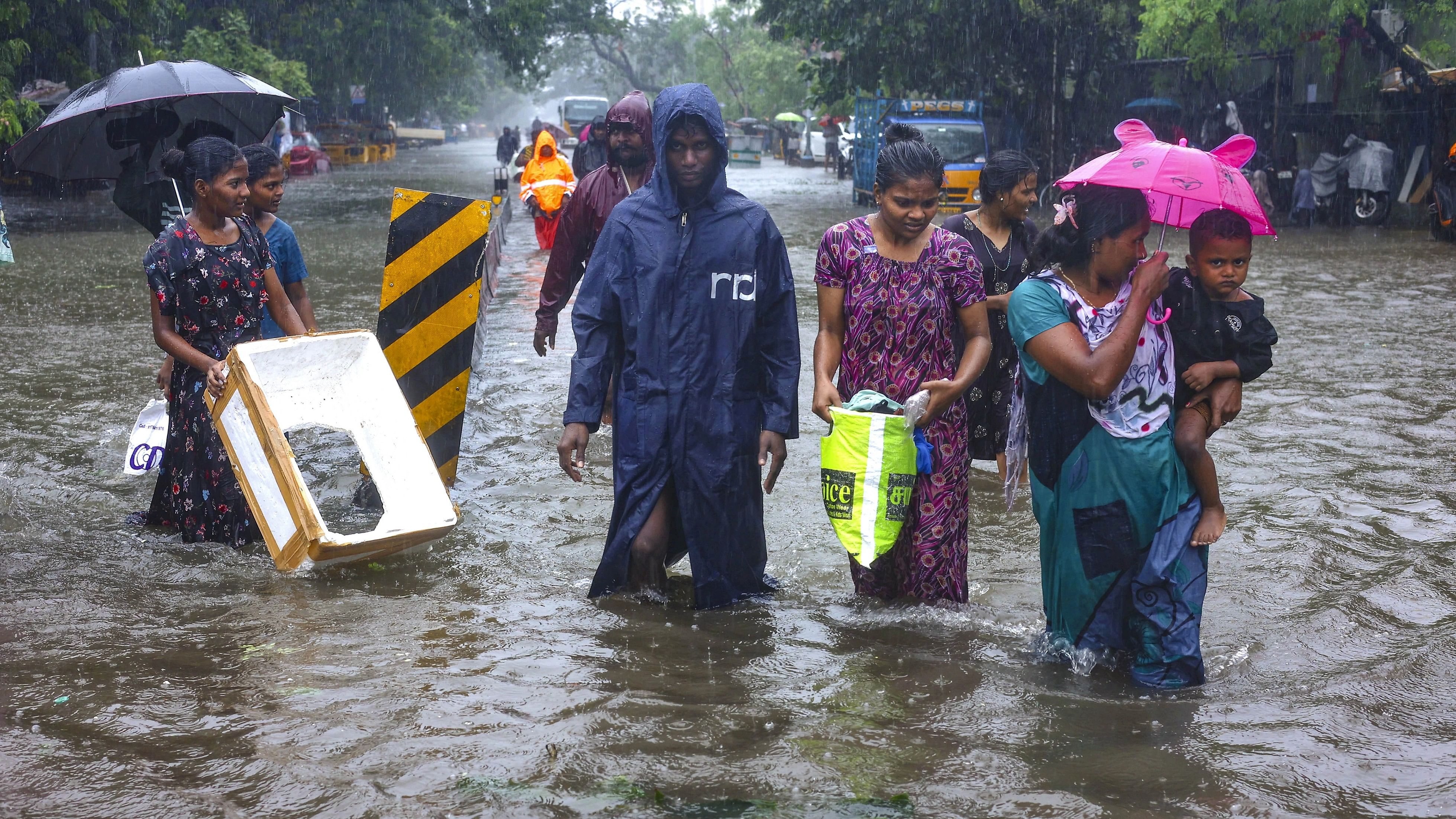
People wade through a waterlogged road during heavy rain owing to Cyclone Michaung, in Chennai, Monday, Dec. 4, 2023.
Credit: PTI Photo
Chennai: Cyclone Michaung, packing winds with a speed of 75 km per hour, battered this metropolis and three neighbouring districts by dumping over 40 cm of rainfall in just 36 hours on Sunday and Monday, leaving a trail of destruction and claiming at least five lives, including a woman, besides damaging properties worth crores of rupees.
Lakhs of Chennaiites were confined to their homes for the better part of Sunday and the whole of Monday with the intensity of the rains refusing to die down, bringing back the scary memories of the 2015 floods when the city was swamped and brought to its knees.
Majority of the areas, including in the core city, were under the water with people taking to every available platform to seek help from authorities and activists to escape floods even as the only airport in Chennai was shut for commercial operations due to heavy waterlogging on the runways.
The city was virtually cut-off from the rest of the country as trains bound for other states from Chennai Central were cancelled after a railway bridge connecting Basin Bridge junction with Vyasarpadi was closed, and National Highways connecting the Tamil Nadu capital with Andhra Pradesh and Karnataka capitals were completely flooded.
The situation was grim as electricity was suspended in most parts of the city and the magnitude of the tragedy will unfold only on Tuesday when the rains are expected to recede. MeT department and independent weather bloggers called it the “biggest rainfall event” since 2015 as the city received a record 12 cm rainfall in just six hours on Monday (8.30 am to 2.30 pm) – the average rainfall of the city in 36 hours crossed 40 cm.
At 10 pm, the cyclone lay around 120 km from Chennai and was moving towards the Andhra Pradesh coast and was to cross between Nellore and Machilipatnam around Tuesday afternoon. Due to the intensity of the rains, the government declared a public holiday for Chennai, Kanchipuram, Tiruvallur, and Chengalpattu districts for the second consecutive day on Tuesday.
Hundreds of people, including pregnant women, were evacuated using boats and ambulances from their marooned homes and apartments in many parts of the city and from low-lying areas like Mudichur, Perungalathur, and Pallikaranai in a coordinated effort by the Indian Army, National Disaster Response Force, and State Disaster Response Force.
Five people, including a woman, died in rain-related incidents in Chennai and its suburbs with two of them losing their lives due to electrocution. Rescue workers couldn’t reach several areas in the city due to intense waterlogging as continuous outpours prevented them from reaching some of the worst-affected areas.
Greater Chennai Corporation Commissioner J Radhakrishnan explained why the water was not receding fast.
“Chennai has 31 micro canals, four major canals, and three rivers through which the rainwater is drained to the Bay of Bengal. Since the tides (waves) are also very heavy, rain water is not going into the sea and that’s the reason for the city facing a cascading effect. Since the city is also at the lower end of Tiruvallur and Kanchipuram, it is suffering more,” he said.
The government opened relief centres across the city and arranged for food to be provided to the needy but most of the affected population couldn’t reach these centres due to flooding on arterial and main roads – at least 17 subways were closed and many areas were marooned.
In the evening, Chief Minister M K Stalin issued a statement asking people to stay indoors and detailing the efforts taken by the government to mitigate the crisis and how the rescue and relief efforts have already begun on a war footing. Stalin said he has deputed at least a dozen ministers to oversee the relief and rehabilitation activities.
He said as many as 4,761 workers have been deployed in the four districts to restore electricity supply as early as possible, 350 boats have been kept ready to rescue people from low-lying areas, and over 1,000 people from several forces have been deployed in rescue operations. The government also appointed senior IAS officers to oversee relief and rehabilitation work in Chennai.
As many as 9,634 people have lodged in 236 relief camps across the state, while 200 ambulances were deployed in Chennai and Tiruvallur districts on Monday and assigned about 450 cases.
Hundreds of trees were uprooted within the city limits and in suburban areas due to the gusty winds with electricity supply being suspended in the majority of localities across Chennai and the three neighbouring districts of Tiruvallur, Chengalpattu, and Kanchipuram.
Several arterial and main roads were flooded due to the continuous rains which has been pouring with almost the same intensity since Sunday night, making it tough for people to travel within the city. Greater Chennai Police said a Green Corridor from Airport to Anna Salai is being maintained for people to use for emergency purposes, while there is a minimum of 1 feet water logging in other roads.
Television footage showed the parking area of several apartments across the city getting flooded with the risk of damage to vehicles, while several vehicles got stuck in knee-deep water in many areas. Many took to social media to share pictures of the level of flooding in their area even as 17 subways were closed for traffic due to heavy waterlogging.
“The situation is quite bad. I had a medical emergency to attend to. And what is normally a 20-minute journey took me 1.5 hours today, and every road was waterlogged,” Kumar, a software professional, told DH.
As rains showed some signs of slowing down after 10 pm, the government said it was restoring power supply to wherever it is possible by the night.